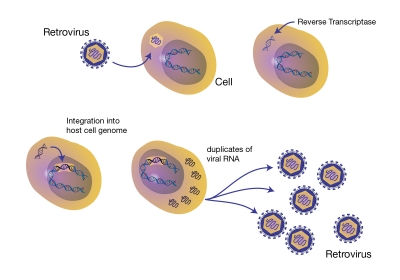
A retrovirus is a virus that uses RNA as its genetic material. When a retrovirus infects a cell, it makes a DNA copy of its genome that is inserted into the DNA of the host cell. There are a variety of different retroviruses that cause human diseases such as some forms of cancer and AIDS.
Retroviruses cause tumour growth and certain cancers in animals and are associated with slow infections of animals, such as equine infectious anemia. In humans, a retrovirus known as human T-cell lymphotropic virus type 1 (HTLV-1) causes a form of cancer called adult T-cell leukemia (ATL). It can also cause a neurodegenerative condition known as HTLV-1-associated myelopathy/tropical spastic paraparesis (HAM/TSP). A closely related virus named HTLV-2 is associated with relatively mild neurological disorders but has not been identified as a causative agent of human disease. As many as 20 million people worldwide are thought to be infected with HTLVs, but only a small percentage of infected individuals actually develop ATL or HAM/TSP. The retrovirus known as human immunodeficiency virus (HIV) causes acquired immunodeficiency syndrome (AIDS) in humans. HIV is closely related to simian immunodeficiency virus (SIV), a retrovirus found in chimpanzees and gorillas.
So-called endogenous retroviruses (ERVs) are persistent features of the genomes of many animals. ERVs consist of the genetic material of extinct, or “fossil,” viruses, the genomic constitution of which is similar to that of extant retroviruses. Human ERVs (HERVs) have become distributed within human DNA over the course of evolution. They are passed from one generation to the next and make up an estimated 1 to nearly 5 percent of the human genome. HERVs are suspected of having influenced the evolution of certain elements of the human genome. They also have been implicated in certain human diseases, including multiple sclerosis.
HTLV-1 was the first human retrovirus to be discovered, having been detected and isolated in 1979 by American virologist Robert C. Gallo and colleagues. HIV was first isolated in 1983.
Credit : Britannica
Picture Credit : Google




